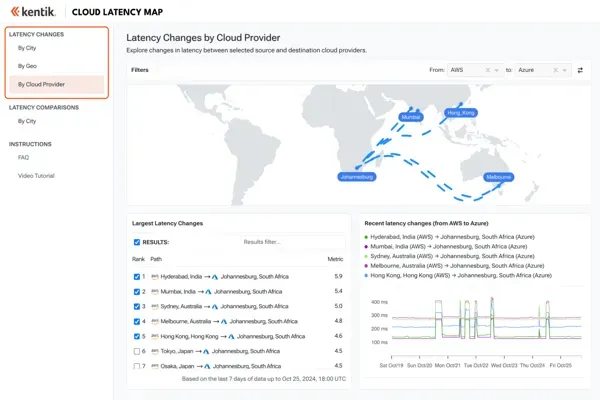Azure cloud latency is becoming a significant concern for users as Microsoft recently announced disruptions caused by the cutting of multiple undersea cables in the Red Sea. This incident has resulted in noticeable delays for clients relying on the Azure platform, especially those accessing services that route through the Middle East or are intended for Asia and Europe. Network disruptions like these not only affect Azure’s performance but also highlight the vulnerability of cloud services to geographical incidents. As Microsoft provides updates on Azure’s status, users are advised to stay informed about potential service interruptions that could impact their operations. Continuous efforts are underway to monitor and optimize routing strategies, ensuring minimal latency impact during this challenging time.
The recent challenges faced by Azure’s cloud services can also be referred to as cloud service latency, stemming from unexpected network interruptions. These delays, primarily influenced by the disruption of undersea cables, have raised discussions about the reliability of global internet infrastructure. Users are increasingly aware of the potential effects that physical network issues, such as those involving undersea fiber, can have on their cloud computing experience. As Microsoft works on an Azure performance update, it is crucial for clients to understand the implications of such disruptions, particularly with respect to services that depend heavily on low-latency connections. Ultimately, the situation serves as a reminder of the interconnectedness of technology and the challenges posed by the global nature of the internet.
Understanding Azure Cloud Latency Concerns
Azure cloud latency refers to the delays that may occur when users access services hosted on Microsoft Azure. With its expansive network of data centers globally, Azure is designed to offer quick response times and efficient service delivery. However, unexpected events, such as the recent undersea cables disruption, can temporarily alter this performance, affecting users’ experience and productivity. The impact is particularly noticeable for businesses relying heavily on cloud applications for their daily operations.
When the undersea cables in the Red Sea were cut, Microsoft Azure identified a significant increase in latency for its clients, particularly those in the Middle East and regions connected to Asia or Europe. This latency can have severe implications for real-time applications, such as video conferencing, online gaming, or active database interactions, where even a slight delay can disrupt service quality. Awareness of these latency issues is critical for organizations that depend on Azure for their operational efficiency.
Impact of Undersea Cables Disruption on Azure Performance
Undersea cables are crucial for global internet connectivity, transmitting vast amounts of data across oceans. The disruption of these cables, as mentioned in the Bloomberg report, has a direct effect on Azure performance, leading to heightened latency and connectivity issues. Microsoft has acknowledged this, stating that users attempting to access services during the disruptions might experience delays, affecting their overall user experience and potentially leading to downtime for critical applications.
Despite these concerns, Microsoft Azure has taken proactive measures to mitigate the effects of the cable disruptions. The company has committed to continuously monitoring the situation, rebalancing traffic loads, and optimizing routing paths to maintain service performance as much as possible. Regular Azure performance updates will be vital for clients during this period, allowing them to stay informed about ongoing latency issues and potential resolutions.
Mitigating Cloud Service Latency for Businesses
For businesses utilizing Microsoft Azure, understanding the implications of cloud service latency is essential for maintaining productivity. The recent issues stemming from the undersea cable disruptions highlight the need for organizations to develop contingency plans. Implementing strategies such as regional failover or establishing secondary connections can help minimize downtime during such events. Organizations must also stay updated on Microsoft Azure status and any notifications related to service performance.
Furthermore, businesses can leverage Azure’s robust capabilities to optimize their service operations. Tools such as application performance monitoring can help identify latency causes and fix bottlenecks, ensuring that user experiences remain efficient even amidst disruptions. Utilizing Azure’s global presence wisely can offer better service robustness, preparing companies to handle unexpected latency issues in the future.
The Role of Microsoft Azure Status in Service Reliability
Keeping track of the Microsoft Azure status is critical for businesses relying on the cloud platform for regular operations. Azure provides real-time updates on service health, performance metrics, and incident reports, which help organizations assess potential impacts on their infrastructure. With recent events like undersea cables disruption, understanding the Azure status allows businesses to make informed decisions and anticipate issues that could affect their cloud services.
Moreover, accessing detailed status updates from Microsoft enables businesses to plan their operational strategies around potential service interruptions. In cases of increased latency or accessibility challenges, companies can redistribute workloads or employ other cloud resources to ensure consistent service delivery. Staying informed and proactive can greatly enhance an organization’s resilience and adaptability in managed cloud environments.
Analyzing Red Sea Internet Issues and Their Broader Implications
The Red Sea internet issues, stemming from the undersea cables cutting, underline the fragile nature of global connectivity and its impact on services like Microsoft Azure. These disruptions can create ripple effects that resonate through various sectors, particularly those dependent on seamless data transmission across continents. As organizations become more reliant on cloud computing, understanding how these cable disruptions affect latency and overall service performance becomes increasingly crucial.
Additionally, the Red Sea internet issues shed light on the need for enhanced infrastructure resilience. The implications of such disruptions highlight the importance of developing alternative routing solutions and redundant systems to safeguard against potential outages. By addressing these concerns, cloud service providers and businesses alike can work towards ensuring a more reliable and stable service environment, reducing the risks associated with single points of failure in global internet architecture.
Future of Cloud Connectivity: Lessons from Current Disruptions
Current disruptions in cloud connectivity, particularly due to undersea cable failures, present valuable lessons for businesses utilizing Azure and other cloud services. It has become increasingly evident that organizations must prioritize connectivity resilience as part of their overall digital strategy. This could involve investing in diversified data pathways and employing advanced technologies to enhance failover capabilities during service interruptions.
Furthermore, cloud service providers, including Microsoft, can learn from these disruptions to strengthen their infrastructure and improve service delivery in the future. Enhanced monitoring capabilities and proactive measures to address latency can create a more robust cloud ecosystem. Companies leveraging Azure must actively engage in fostering close partnerships with their service providers, ensuring a collaborative approach to managing connectivity and performance challenges.
Customer Support During Azure Performance Issues
When Azure performance issues arise due to factors like undersea cable disruptions, customer support plays a pivotal role in maintaining user trust and satisfaction. Microsoft Azure offers various support channels for clients to report issues and seek guidance on managing latency impacts. Quick access to knowledgeable support resources can help businesses understand the situation further and mitigate disruptions effectively.
Additionally, organizations using Azure should engage proactively with customer service during performance issues. Communicating potential impacts on business operations and seeking tailored solutions can enhance service experiences. Regular feedback loops between customers and Azure representatives can ensure that concerns are addressed, ultimately leading to improved service reliability and performance enhancements over time.
Understanding the Importance of Redundant Internet Paths
The need for redundant internet paths has become increasingly apparent in light of recent undersea cable disruptions affecting Azure cloud services. Redundant pathways allow data to reroute during outages, minimizing latency and ensuring uninterrupted service. For companies relying heavily on cloud solutions provided by Azure, developing a strategy based on redundancy is vital for safeguarding against potential disruptions.
Implementing redundant internet pathways not only secures connectivity but also enhances overall system resilience. Organizations should collaborate with their IT teams and Azure service providers to assess current infrastructure and identify areas for improvement. As disruptions become more frequent in an interconnected world, prioritizing redundancy will be a key factor in maintaining seamless cloud service operations and achieving business continuity.
Building Awareness: The Role of Communication in Mitigation Strategies
Effective communication plays a crucial role in mitigating the impact of latency caused by disruptions, such as those seen with the Azure cloud platform. Companies must prioritize transparency when informing their teams about service status updates and potential service impacts due to undersea cable cuts. By keeping employees in the loop, organizations can ensure preparedness and adaptability, which ultimately influences productivity.
Additionally, communication between Microsoft and its Azure clients is vital in these situations. Regular updates regarding Azure status, including estimated resolution times and ongoing management of performance issues, help clients devise strategic actions to limit the effects of latency. Cultivating an environment of openness fosters trust and enhances the overall customer experience, proving essential in times of uncertainty.
Frequently Asked Questions
What is Azure cloud latency and how does it affect services?
Azure cloud latency refers to the delay or lag experienced when data is transmitted between the Azure cloud services and users. This latency can impact the performance of applications hosted on Azure, resulting in slower response times and decreased user experience.
How can undersea cables disruption affect Azure cloud latency?
Disruptions to undersea cables, such as those recently reported in the Red Sea, can significantly increase Azure cloud latency. This occurs because data may need to take longer alternative routes, leading to higher latency values for users accessing services through affected regions.
What did Microsoft Azure status report about performance during undersea cable issues?
Microsoft Azure status indicated that clients could experience increased latency due to disruptions caused by damaged undersea cables in the Red Sea. The company is committed to monitoring the situation and optimizing routing to mitigate the impact on Azure performance.
Are there any known issues affecting Azure cloud latency due to recent disruptions?
Yes, recent issues due to the cutting of undersea cables have led to increased latency for Azure services. Microsoft has acknowledged the disruption and is actively working to minimize customer impact based on their Azure performance updates.
What are the implications of Red Sea internet issues on Microsoft Azure services?
Red Sea internet issues, primarily related to undersea cable cuts, can cause increased latency for Microsoft Azure users, particularly those connecting to services in Europe or Asia. These disruptions can lead to slower communication and data transfer rates.
How long does it take to repair undersea cables that affect Azure cloud latency?
Repairs for undersea cables can take a significant amount of time, potentially extending the period during which Azure cloud latency is affected. Microsoft continuously monitors the situation to provide the best possible routing and minimize delays for users.
What steps does Microsoft take to optimize Azure performance during latency issues?
During latency issues related to undersea cable disruptions, Microsoft takes steps to rebalance and optimize routing for Azure services. This proactive approach helps to reduce the impact of delays on user experience while service is affected.
When will latency issues related to Azure cloud services be resolved?
While Microsoft continually monitors the situation, the resolution of latency issues caused by undersea cable disruptions depends on the repair timeline of the cables. Users can refer to the official Azure status page for updates on any ongoing issues.
| Key Point | Details |
|---|---|
| Latency Issues | Increased latency reported by Azure clients due to undersea cable cuts. |
| Affected Areas | Traffic affected involves routes through the Middle East and connections to Asia or Europe. |
| Cause | Cables were cut, but Microsoft did not disclose who was responsible or why. |
| Repair Time | Undersea fiber cuts require time for repairs and optimizing may take additional time. |
| Current Status | As of Saturday evening, Microsoft confirmed no ongoing issues with Azure services. |
Summary
Azure cloud latency has arisen due to recent disruptions caused by undersea cable cuts in the Red Sea, impacting user experience significantly. Microsoft has acknowledged these issues, particularly affecting data traffic between the Middle East and Europe or Asia. Despite the setbacks, the company is actively monitoring the situation and responding to minimize customer impact. By the end of Saturday, they reported that the connectivity problems were resolved, indicating a swift return to normal operations.



























